七年级英语下册Unit1Writingatravelguide教学设计(新版)牛津上海版(新)
- 格式:doc
- 大小:35.00 KB
- 文档页数:4
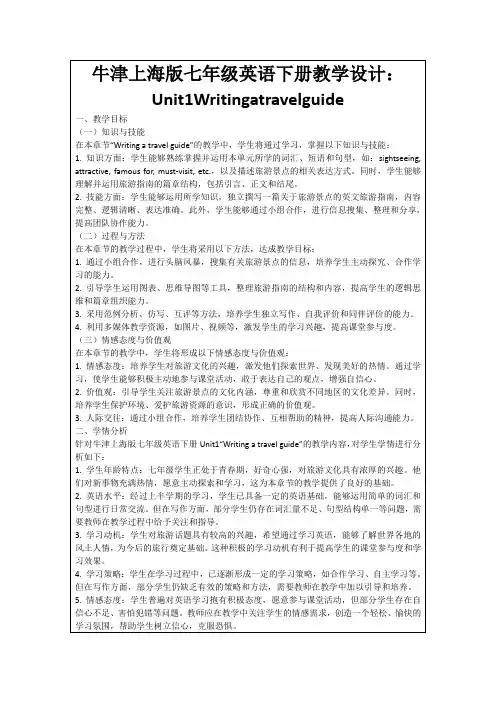
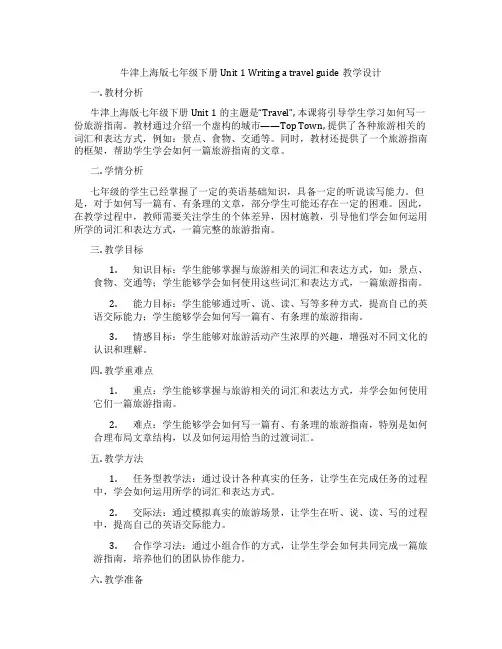
牛津上海版七年级下册 Unit 1 Writing a travel guide教学设计一. 教材分析牛津上海版七年级下册Unit 1的主题是“Travel”, 本课将引导学生学习如何写一份旅游指南。
教材通过介绍一个虚构的城市——Top Town, 提供了各种旅游相关的词汇和表达方式,例如:景点、食物、交通等。
同时,教材还提供了一个旅游指南的框架,帮助学生学会如何一篇旅游指南的文章。
二. 学情分析七年级的学生已经掌握了一定的英语基础知识,具备一定的听说读写能力。
但是,对于如何写一篇有、有条理的文章,部分学生可能还存在一定的困难。
因此,在教学过程中,教师需要关注学生的个体差异,因材施教,引导他们学会如何运用所学的词汇和表达方式,一篇完整的旅游指南。
三. 教学目标1.知识目标:学生能够掌握与旅游相关的词汇和表达方式,如:景点、食物、交通等;学生能够学会如何使用这些词汇和表达方式,一篇旅游指南。
2.能力目标:学生能够通过听、说、读、写等多种方式,提高自己的英语交际能力;学生能够学会如何写一篇有、有条理的旅游指南。
3.情感目标:学生能够对旅游活动产生浓厚的兴趣,增强对不同文化的认识和理解。
四. 教学重难点1.重点:学生能够掌握与旅游相关的词汇和表达方式,并学会如何使用它们一篇旅游指南。
2.难点:学生能够学会如何写一篇有、有条理的旅游指南,特别是如何合理布局文章结构,以及如何运用恰当的过渡词汇。
五. 教学方法1.任务型教学法:通过设计各种真实的任务,让学生在完成任务的过程中,学会如何运用所学的词汇和表达方式。
2.交际法:通过模拟真实的旅游场景,让学生在听、说、读、写的过程中,提高自己的英语交际能力。
3.合作学习法:通过小组合作的方式,让学生学会如何共同完成一篇旅游指南,培养他们的团队协作能力。
六. 教学准备1.教师准备:提前准备好与旅游相关的图片、视频等教学素材;准备好旅游指南的框架和示例文章。
2.学生准备:学生提前预习课文,了解本课的主题和内容。
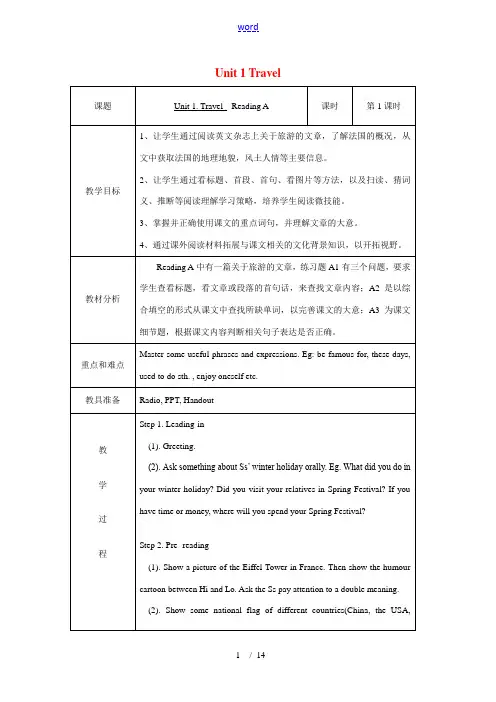
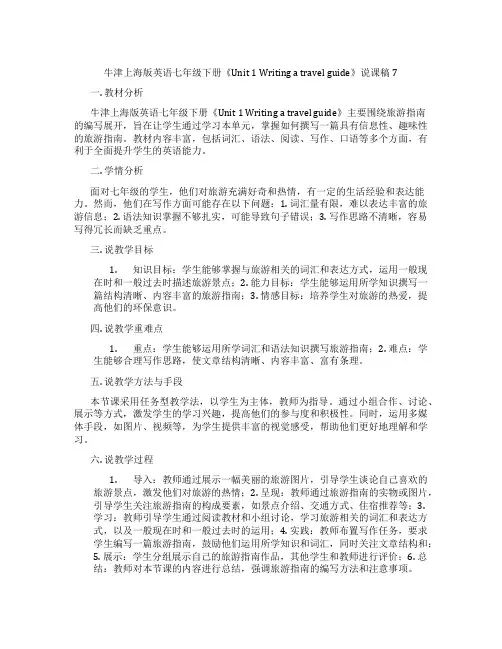
牛津上海版英语七年级下册《Unit 1 Writing a travel guide》说课稿7一. 教材分析牛津上海版英语七年级下册《Unit 1 Writing a travel guide》主要围绕旅游指南的编写展开,旨在让学生通过学习本单元,掌握如何撰写一篇具有信息性、趣味性的旅游指南。
教材内容丰富,包括词汇、语法、阅读、写作、口语等多个方面,有利于全面提升学生的英语能力。
二. 学情分析面对七年级的学生,他们对旅游充满好奇和热情,有一定的生活经验和表达能力。
然而,他们在写作方面可能存在以下问题:1. 词汇量有限,难以表达丰富的旅游信息;2. 语法知识掌握不够扎实,可能导致句子错误;3. 写作思路不清晰,容易写得冗长而缺乏重点。
三. 说教学目标1.知识目标:学生能够掌握与旅游相关的词汇和表达方式,运用一般现在时和一般过去时描述旅游景点;2. 能力目标:学生能够运用所学知识撰写一篇结构清晰、内容丰富的旅游指南;3. 情感目标:培养学生对旅游的热爱,提高他们的环保意识。
四. 说教学重难点1.重点:学生能够运用所学词汇和语法知识撰写旅游指南;2. 难点:学生能够合理写作思路,使文章结构清晰、内容丰富、富有条理。
五. 说教学方法与手段本节课采用任务型教学法,以学生为主体,教师为指导。
通过小组合作、讨论、展示等方式,激发学生的学习兴趣,提高他们的参与度和积极性。
同时,运用多媒体手段,如图片、视频等,为学生提供丰富的视觉感受,帮助他们更好地理解和学习。
六. 说教学过程1.导入:教师通过展示一幅美丽的旅游图片,引导学生谈论自己喜欢的旅游景点,激发他们对旅游的热情;2. 呈现:教师通过旅游指南的实物或图片,引导学生关注旅游指南的构成要素,如景点介绍、交通方式、住宿推荐等;3.学习:教师引导学生通过阅读教材和小组讨论,学习旅游相关的词汇和表达方式,以及一般现在时和一般过去时的运用;4. 实践:教师布置写作任务,要求学生编写一篇旅游指南,鼓励他们运用所学知识和词汇,同时关注文章结构和;5. 展示:学生分组展示自己的旅游指南作品,其他学生和教师进行评价;6. 总结:教师对本节课的内容进行总结,强调旅游指南的编写方法和注意事项。
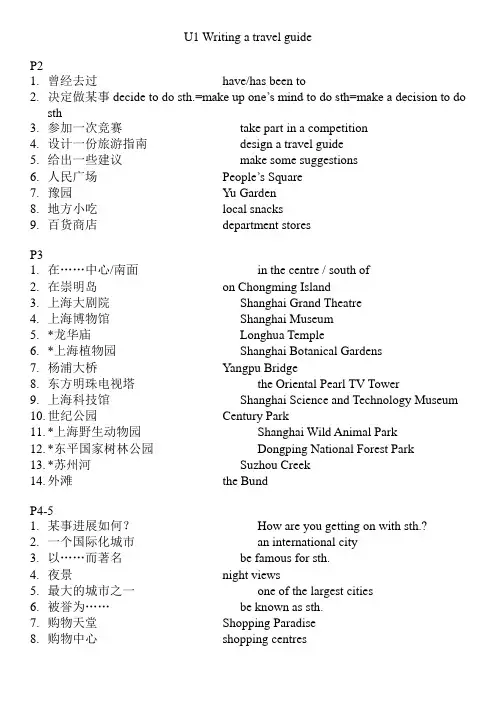
P21.曾经去过have/has been to2.决定做某事decide to do sth.=make up one’s mind to do sth=make a decision to dosth3.参加一次竞赛take part in a competition4.设计一份旅游指南design a travel guide5.给出一些建议make some suggestions6.人民广场People’s Square7.豫园Yu Garden8.地方小吃local snacks9.百货商店department storesP31.在……中心/南面in the centre / south of2.在崇明岛on Chongming Island3.上海大剧院Shanghai Grand Theatre4.上海博物馆Shanghai Museum5.*龙华庙Longhua Temple6.*上海植物园Shanghai Botanical Gardens7.杨浦大桥Yangpu Bridge8.东方明珠电视塔the Oriental Pearl TV Tower9.上海科技馆Shanghai Science and Technology Museum10.世纪公园Century Park11.*上海野生动物园Shanghai Wild Animal Park12.*东平国家树林公园Dongping National Forest Park13.*苏州河Suzhou Creek14.外滩the BundP4-51.某事进展如何?How are you getting on with sth.?2.一个国际化城市an international city3.以……而著名be famous for sth.4.夜景night views5.最大的城市之一one of the largest cities6.被誉为……be known as sth.7.购物天堂Shopping Paradise8.购物中心shopping centres9.(做)某事是……样的。
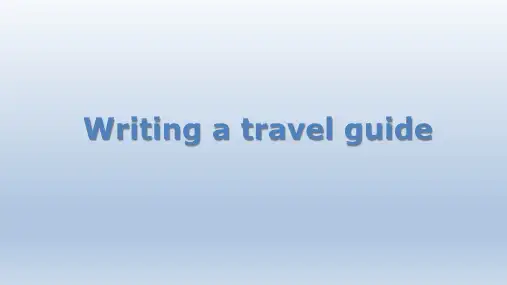
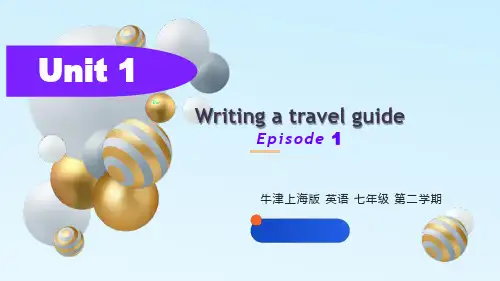
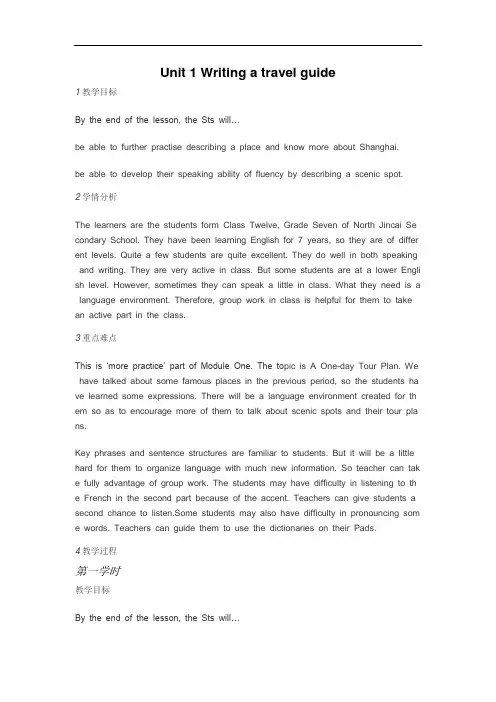
Unit 1 Writing a travel guide1教学目标By the end of the lesson, the Sts will…be able to further practise describing a place and know more about Shanghai.be able to develop their speaking ability of fluency by describing a scenic spot.2学情分析The learners are the students form Class Twelve, Grade Seven of North Jincai Se condary School. They have been learning English for 7 years, so they are of differ ent levels. Quite a few students are quite excellent. They do well in both speaking and writing. They are very active in class. But some students are at a lower Engli sh level. However, sometimes they can speak a little in class. What they need is a language environment. Therefore, group work in class is helpful for them to take an active part in the class.3重点难点This is ‘more practice’ part of Module One. The to pic is A One-day Tour Plan. We have talked about some famous places in the previous period, so the students ha ve learned some expressions. There will be a language environment created for th em so as to encourage more of them to talk about scenic spots and their tour pla ns.Key phrases and sentence structures are familiar to students. But it will be a little hard for them to organize language with much new information. So teacher can tak e fully advantage of group work. The students may have difficulty in listening to th e French in the second part because of the accent. Teachers can give students a second chance to listen.Some students may also have difficulty in pronouncing som e words. Teachers can guide them to use the dictionaries on their Pads.4教学过程第一学时教学目标By the end of the lesson, the Sts will…be able to further practise describing a place and know more about Shanghai.be able to develop their speaking ability of fluency by describing a scenic spot.学时重点This is ‘more practice’ part of Module One. The topic is A One-day Tour Plan. We have talked about some famous places in the previous period, so the students ha ve learned some expressions. There will be a language environment created for th em so as to encourage more of them to talk about scenic spots and their tour pla ns.学时难点Key phrases and sentence structures are familiar to students. But it will be a little hard for them to organize language with much new information. So teacher can tak e fully advantage of group work. The students may have difficulty in listening to th e French in the second part because of the accent. Teachers can give students a second chance to listen.Some students may also have difficulty in pronouncing som e words. Teachers can guide them to use the dictionaries on their Pads.教学活动活动1【导入】Lead inIt’s said that they really enjoyed the trip to Shanghai. Do you want to know where they have been? I will show you some pictures of places they’ve been. Please ta ke notes when you are watching.T gives the following instructions:1. I will show you some pictures of places they’ve been.2. Please take notes when you are watching.3. After that, please tell me how many places are there altogether and what they are.T shows four pictures of some places.S answers according to the picture.T corrects the mistakes and may show the pictures again if necessary.(Pudong International Airport, the bund, Yu garden, Shanghai zoo, Xintiandi, Shang hai Science and Technology Museum and Shanghai Museum)活动2【活动】Input-listeningT: Among these pictures, do you know their favourite place?Students may give some answers or no answer.T: I’ve invited 4 French students to talk about their favourite places. Let’s listen to them. Please take notes while listening.T plays the recording one by one.T invites students to give answers and give reasons.T gives feedback if the students’ answers are wrong.活动3【活动】Input-readingT: French students told me that they wanted to know more about Shanghai, about those they have been to, and also about those they haven’t. Would you please giv e them some introductions about more places? First, you need to read some instru ctions.T gives the instructions.1. Work in a group of 6.2. Each group needs to read 8 passages and find useful information as much as possible.3. Take notes and finish the table.4. Group A is responsible for sightseeing, Group B shopping and Group C eating. T provides individual drilling.活动4【活动】Output-an introduction about a scenic spotT invites some students to introduce some scenic spots according to the informatio n they have taken down.T gives feedbacks about their presentations.活动5【活动】Output-a tour planT: I think they will enjoy those places. So why not make a tour plan for them? Ple ase discuss with your group members and make a one-day tour plan for them. Ea ch group needs to focus on your task. (Group A sightseeing Group B eating Group C shopping.)T provides individual drilling.T invites some students to give presentations about their tour plans.T gives feedbacks about their presentations.活动6【作业】AssignmentT: Write down your 3-day tour plan for French students. The school may use your plan next year.e.g.: On the first day, they are going to …。
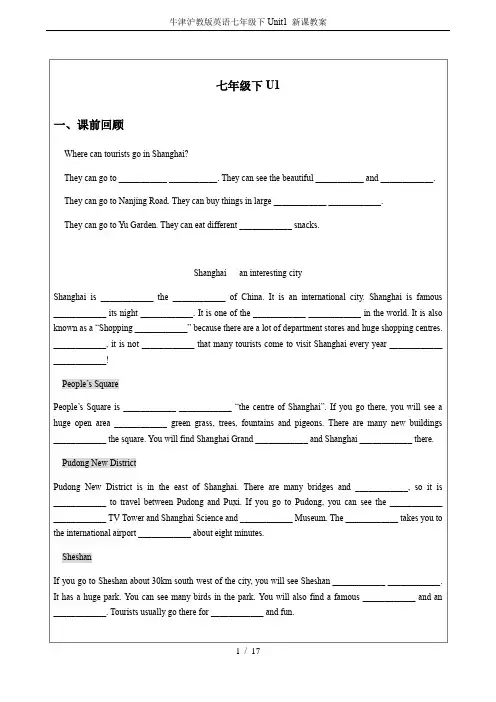
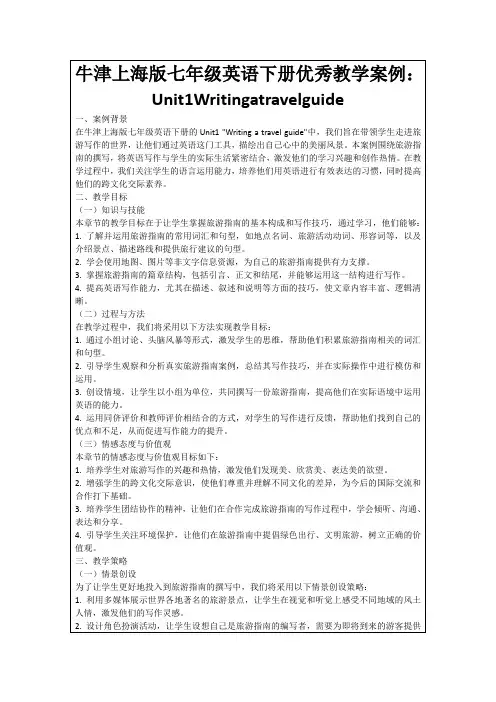
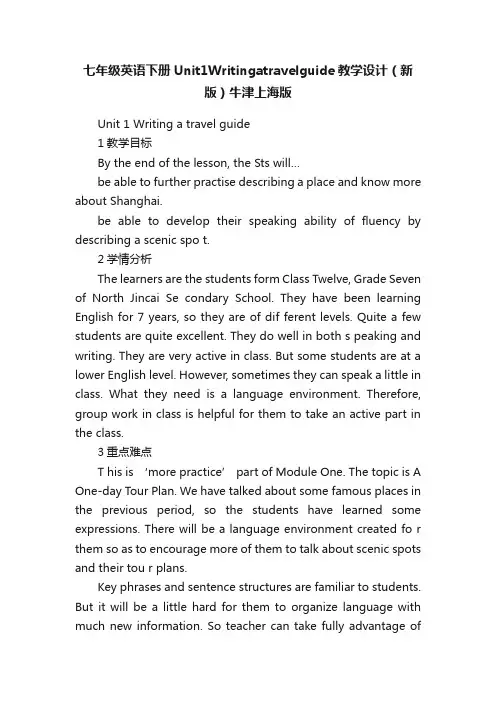
七年级英语下册Unit1Writingatravelguide教学设计(新版)牛津上海版Unit 1 Writing a travel guide1教学目标By the end of the lesson, the Sts will…be able to further practise describing a place and know more about Shanghai.be able to develop their speaking ability of fluency by describing a scenic spo t.2学情分析The learners are the students form Class Twelve, Grade Seven of North Jincai Se condary School. They have been learning English for 7 years, so they are of dif ferent levels. Quite a few students are quite excellent. They do well in both s peaking and writing. They are very active in class. But some students are at a lower English level. However, sometimes they can speak a little in class. What they need is a language environment. Therefore, group work in class is helpful for them to take an active part in the class.3重点难点T his is ‘more practice’ part of Module One. The topic is A One-day Tour Plan. We have talked about some famous places in the previous period, so the students have learned some expressions. There will be a language environment created fo r them so as to encourage more of them to talk about scenic spots and their tou r plans.Key phrases and sentence structures are familiar to students. But it will be a little hard for them to organize language with much new information. So teacher can take fully advantage ofgroup work. The students may have difficulty in li stening to the French in the second part because of the accent. Teachers can gi ve students a second chance to listen.Some students may also have difficulty in pronouncing some words. Teachers can guide them to use the dictionaries on the ir Pads.4教学过程第一学时教学目标By the end of the lesson, the Sts will…be able to further practise describing a place and know more about Shanghai.be able to develop their speaking ability of fluency by describing a scenic spo t.学时重点This is ‘more practice’ part of Module One. The topic is A One-day Tour Plan. We have talked about some famous places in the previous period, so the students have learned some expressions. There will be a language environment created fo r them so as to encourage more of them to talk about scenic spots and their tou r plans.学时难点Key phrases and sentence structures are familiar to students. But it will be a little hard for them to organize language with much new information. So teacher can take fully advantage of group work. The students may have difficulty in li stening to the French in the second part because of the accent. Teachers can gi ve students a second chance to listen.Some students may also have difficulty in pronouncing some words. Teachers can guide them to use the dictionaries on the ir Pads.教学活动活动1【导入】Lead inIt’s said that they really enjoyed the trip to Shanghai. Do you want to know w here they have been? I will show you some pictures of places they’ve been. Ple ase take notes when you are watching.T gives the following instructions:1. I will show you some pictures of places they’ve been.2. Please take notes when you are watching.3. After that, please tell me how many places are there altogether and what the y are.T shows four pictures of some places.S answers according to the picture.T corrects the mistakes and may show the pictures again if necessary.(Pudong International Airport, the bund, Yu garden, Shanghai zoo, Xintiandi, Sh anghai Science and T echnology Museum and Shanghai Museum)活动2【活动】Input-listeningT: Among these pictures, do you know their favourite place?Students may give some answers or no answer.T: I’ve invited 4 French students to talk about their favourite places. Let’s listen to them. Please take notes while listening.T plays the recording one by one.T invites students to give answers and give reasons.T gives feedback if the students’ answers are wrong.活动3【活动】Input-readingT: French students told me that they wanted to know more about Shanghai, about those they have be en to, and also about those they haven’t. Would you please g ive them some introductions about more places? First, you need to read someins tructions.T gives the instructions.1. Work in a group of 6.2. Each group needs to read 8 passages and find useful information as much as p ossible.3. Take notes and finish the table.4. Group A is responsible for sightseeing, Group B shopping and Group C eating. T provides individual drilling.活动4【活动】Output-an introduction about a scenic spot。
Unit 1 Writing a travel guide【教学目标】1.To read and spell some new words correctly.2.To talk about places of interest in Shanghai.【教学重难点】1.New words and phrases (especially the names of places of interest).2.Difficulties: too many new words; Read the map of Shanghai.【教学过程】活动1导入I. Pre-task preparation1.Think and sayShow Chinese meanings of phrases and as ss to tell us the English names.2.Look, point and learnLook at the pictures, and review some more places in Shanghai.活动2讲授Ⅱ. While-task procedure1.Look and sayLook at the picture and guess what they are doing now.Kitty and her classmates have just been to Shanghai. They have decided to take part in a competition.1) Give students some time to listen to the dialogue and write down the reasons.2) Ask and answer some questions after it.Q1: Where can tourists go in Shanghai?Q2: What can they do there?3) Ask students to listen to the dialogue again, and ask students to repeat it one by one.4) Give students some time to practice reading the dialogue.5) Ask them to have a role-play.2.Look at the pictures and learn ‘sightseeing’.1) Look at the picture, what does the woman in the photos like to do?She likes to go sightseeing.2) Think: Where can tourists go for sightseeing/shopping/eating in Shanghai? Talk in pairs. Suggest some places tourists can visit in Shanghai.S1: Where can tourists go in Shanghai?S2: They can go to _____.S1: Where is _____?S2: It’s in the centre/ south/…of Shanghai.on Chongming Island.S1: What can they do there?S2: They can see/ eat/ buy/ visit/….活动3练习Ⅲ. Post-task activities1.Listen, choose and write.Listen to a dialogue and take some notes.2.Read the new words on the blackboard.活动4作业V. AssignmentCopy the phrases twice and recite it, prepare for the dictation next day. Recite, listen and say.Preview the next two pages.。
牛津版上海版七年级下册 Unit 1 Writing a travel guide说课稿一. 教材分析牛津版上海版七年级下册Unit 1的主题是“Travel”, 本课主要让学生学会如何写一个旅游指南。
通过学习本课, 学生将能够了解如何描述一个地方, 如何表达旅游建议, 以及如何使用适当的旅游词汇。
教材内容丰富, 插图精美, 激发学生的学习兴趣,同时也提供了丰富的语言实践活动, 帮助学生更好地掌握所学知识。
二. 学情分析面对的是七年级的学生,他们已经掌握了一定的英语基础知识,具备一定的听、说、读、写的能力。
但是,对于如何写一个旅游指南,他们可能还没有明确的思路和方法。
此外,对于一些旅游相关的词汇和表达方式,他们可能还不太熟悉。
因此,在教学过程中,需要注重指导学生的写作方法和技巧,同时也要提供足够的语言输入,帮助他们更好地理解和掌握所学知识。
三. 说教学目标1.知识目标能够理解和运用旅游相关的词汇和表达方式。
能够描述一个地方,并给出旅游建议。
2.能力目标能够听、说、读、写关于旅游的内容。
能够写出一个简单的旅游指南。
3.情感目标激发学生对旅游的兴趣和热情。
培养学生的合作意识和团队精神。
四. 说教学重难点能够描述一个地方,并给出旅游建议。
能够听、说、读、写关于旅游的内容。
如何运用适当的旅游词汇和表达方式。
如何文章结构,写出一个完整的旅游指南。
五. 说教学方法与手段采用任务型教学法,通过各种语言实践活动,让学生在实际操作中学习和掌握知识。
利用多媒体教学手段,如图片、视频等,激发学生的学习兴趣,提供丰富的语言输入。
采用分组合作的学习方式,培养学生的团队合作能力和沟通能力。
六. 说教学过程通过展示一些旅游胜地的图片,引导学生谈论他们最喜欢的旅游地,激发学生的学习兴趣。
2.课堂活动学生分组,每组选择一个旅游目的地,根据教材提供的提示,编写一个旅游指南。
在编写过程中,教师提供必要的帮助和指导,如旅游词汇的运用,文章结构的安排等。
牛津上海版七年级下册 Unit 1 Writing a travel guide说课稿一. 教材分析牛津上海版七年级下册Unit 1的主题是“Travel”,本节课的主要内容是让学生学会如何写一份旅游指南。
教材通过提供一个关于上海的城市介绍,让学生学习如何信息,如何使用适当的旅游相关词汇和句型,以及如何根据不同场景进行写作。
教材内容丰富,贴近学生生活,能够激发学生学习兴趣。
二. 学情分析面对七年级的学生,他们在之前的学习中已经掌握了基本的英语语法和词汇,具备一定的写作能力。
然而,对于如何写旅游指南这类实用性文本,他们可能还比较陌生。
因此,在教学过程中,需要帮助学生理解旅游指南的结构和特点,以及如何运用恰当的词汇和句型进行写作。
三. 说教学目标1.知识目标:学生能够掌握旅游指南的基本结构和常用表达方式,学会使用旅游相关词汇。
2.能力目标:学生能够运用所学知识,编写一篇结构清晰、内容丰富的旅游指南。
3.情感目标:通过学习,学生能够提高对旅游的兴趣,增强对生活的热爱。
四. 说教学重难点1.重点:学生能够掌握旅游指南的基本结构和常用表达方式,学会使用旅游相关词汇。
2.难点:学生能够灵活运用所学知识,编写一篇结构清晰、内容丰富的旅游指南。
五. 说教学方法与手段为了更好地实现教学目标,我将以任务型教学法为主,结合交际法、情境教学法和合作学习法进行教学。
在教学过程中,我将使用多媒体手段,如图片、视频和网络资源,来丰富教学内容,激发学生的学习兴趣。
六. 说教学过程1.导入:通过展示上海旅游景点的图片,引导学生谈论他们对旅游的喜爱,激发他们对本节课的兴趣。
2.新课呈现:通过旅游指南的实物,介绍旅游指南的基本结构和常用表达方式。
3.学习活动:学生分组进行讨论,根据所学知识,编写一篇旅游指南。
4.实践环节:学生展示自己的旅游指南作品,其他学生和老师进行评价和反馈。
5.总结:对本节课的内容进行总结,强调旅游指南的写作技巧。
Unit One Writing a travel guideI 词组:参加竞赛take part in a competition入党join the Party设计一个旅游指南design a travel guide提一些建议make some suggestions去人民广场go to People’s Square看喷泉和鸽子see fountains and pigeons吃不同的地方小吃eat different local snacks去南京路go to Nanjing Road在大型百货公司购物buy things in large department stores去过某地(已返回)have been to …去了某地(未返回)have gone to …在某地have been in在上海市中心in the centre of Shanghai在上海的南部in the south of(东、南、西、北) (east, south, west, north)(东南、东北、西南、西北) (south-east, north-east,south-west, north-west)east of, in the east of, to the east of, on the east of上海西南30公里30 km south-west of Shanghai观光go sightseeing欣赏它的夜景enjoy its night views苏州河the Suzhou Creek黄浦江the Huangpu River东方明珠电视塔the Oriental Pearl TV Tower上海大剧院Shanghai Grand Theatre上海植物园Shanghai botanical garden上海博物馆Shanghai Museum豫园Yu Garden世纪公园Century Park上海科技馆Shanghai Science and Technology Museum 卢浦大桥Lupu Bridge外滩the Bund在崇明岛上on Chongming Island以……闻名be famous for被誉为be known as浦东新区Pudong New District……不足为奇It’s not surprising that ….来上海购物come to Shanghai to shop一大块开放式绿地 a huge open area with green grass 广场周围around the square国家旅游度假区state resort一个天文台an observatory购物天堂shopping paradise在浦东、浦西之间往来travel between Pudong and Puxi 去那观光游玩go there for sightseeing and fun 做某事是很方便的It is convenie nt to do….想出think of进展get on with目录页contents page介绍某人去有趣的地方introduce sb. to interesting places 水上餐厅floating restaurants如果你去,你将会看到/发现…… If you go to…, you will see/find… 在上海游客可以去哪里Where can tourists go in Shanghai他们可以去…They can go to ….1. surprise surprised surprising2. interest interested interesting3. excite excited exciting4. please pleased pleasant5. relax relaxed relaxing6. move moved moving7. bore bored boring8. frighten frightened frightening 【知识点梳理】导学祥案Page 2词汇neighbor n. 邻居【联想】neighbourhood n. 住宅区guide n. 指南;手册;You’d better buy a travel guide when you are travelling in a foreign country. 当你在外国旅行时,你最好买一本旅游指南。
牛津沪教版英语七年级下Un itl复习教案U1 Writ ing a travel guide教学过程:1. 词汇梳2. 重要句型及语3. 课堂练4. 家庭作Part词汇梳理1. guid nv.(1) guid作名词时,可以表示①导游The guide took us around the Palace Museum.导游带我们参观了故宫②导游手相当guidebookDo you need a guide?It tells you a lot about the Forbidden City. 你需要一本导游手吗?它会告诉你很多关于紫禁城的信息③指南 A Guide to English Grammar《英语语法指南⑵guid作动词时,可以表…领路,带的意思。
如Marti n guided him to the recepti on room. 马丁把他领到接待室批注:让学生注意分guid 的两种词2. tour n旅行;旅Can you give us some tour suggestions? 你能给我们一些旅行建议吗【联想touristn.游客,旅游3. reason n.原因,理The reason why she was late was that she forgot to set the clock. 她迟到的原因是因为忘记了定闹钟【近义词causen.原因,起因,缘故;理【拓展reasonableadj.合理的,明智批注the reason wh 的句可以让学生用在写作中3. take part in 参加(活动如We'll take part in the sports meeting this Friday.本周五我们要参加运动会They have decided to take part in a competition. 他们决定参加一个竞赛【比较take part ijoin都参的意思take part in表示参加某项活动joi示参加或加入某个团体或组织女口He joined the Party ten years ago 他十年前入党I'll join the Youth League n ext mon th.下个月我要入团【提示take part in = join in批注:注take part injoi 的区4. sightsee ingn 观光;游Tourists usually go there for sightseei ng and fun 游客们通常会去那儿观光游玩【记忆go sightsee in去观【联想go shoppin 去购物go swimmin 去游泳go fishin 去钓鱼go travellin 去旅游11/ 1复习教案牛津沪教版英语七年级下Unit1去徒步旅行go boating去划船;go hiking go camping 去野营;go cycling 去骑车;去打猎go windsurfing 去风帆冲浪;go hunting go skating 去溜冰;观光旅游 a sightseeing tour【拓展】a sightseeing bus观光旅游车的中部位于... 5. in the cen tre ofin the middle of强调与四周距离相等的中心位置,常用来指空间;【比较】in the centre of强调两端之间的位置,并不强调中心,既可用于指空间,也可用于指时间。
Unit 1 Writing a travel guide1教学目标By the end of the lesson, the Sts will…be able to further practise describing a place and know more about Shanghai.be able to develop their speaking ability of fluency by describing a scenic spo t.2学情分析The learners are the students form Class Twelve, Grade Seven of North Jincai Se condary School. They have been learning English for 7 years, so they are of dif ferent levels. Quite a few students are quite excellent. They do well in both s peaking and writing. They are very active in class. But some students are at a lower English level. However, sometimes they can speak a little in class. What they need is a language environment. Therefore, group work in class is helpful for them to take an active part in the class.3重点难点This is ‘more practice’ part of Module One. The topic is A One-day Tour Plan. We have talked about some famous places in the previous period, so the students have learned some expressions. There will be a language environment created fo r them so as to encourage more of them to talk about scenic spots and their tou r plans.Key phrases and sentence structures are familiar to students. But it will be a little hard for them to organize language with much new information. So teacher can take fully advantage of group work. The students may have difficulty in li stening to the French in the second part because of the accent. Teachers can gi ve students a second chance to listen.Some students may also have difficulty in pronouncing some words. Teachers can guide them to use the dictionaries on the ir Pads.4教学过程第一学时教学目标By the end of the lesson, the Sts will…be able to further practise describing a place and know more about Shanghai.be able to develop their speaking ability of fluency by describing a scenic spo t.学时重点This is ‘more practice’ part of Module One. The topic is A One-day Tour Plan. We have talked about some famous places in the previous period, so the students have learned some expressions. There will be a language environment created fo r them so as to encourage more of them to talk about scenic spots and their tou r plans.学时难点Key phrases and sentence structures are familiar to students. But it will be a little hard for them to organize language with much new information. So teacher can take fully advantage of group work. The students may have difficulty in li stening to the French in the second part because of the accent. Teachers can gi ve students a second chance to listen.Some students may also have difficulty in pronouncing some words. Teachers can guide them to use the dictionaries on the ir Pads.教学活动活动1【导入】Lead inIt’s said that they really enjoyed the trip to Shanghai. Do you want to know w here they have been? I will show you some pictures of places they’ve been. Ple ase take notes when you are watching.T gives the following instructions:1. I w ill show you some pictures of places they’ve been.2. Please take notes when you are watching.3. After that, please tell me how many places are there altogether and what the y are.T shows four pictures of some places.S answers according to the picture.T corrects the mistakes and may show the pictures again if necessary.(Pudong International Airport, the bund, Yu garden, Shanghai zoo, Xintiandi, Sh anghai Science and Technology Museum and Shanghai Museum)活动2【活动】Input-listeningT: Among these pictures, do you know their favourite place?Students may give some answers or no answer.T: I’ve invited 4 French students to talk about their favourite places. Let’s listen to them. Please take notes while listening.T plays the recording one by one.T invites students to give answers and give reasons.T gives feedback if the students’ answers are wrong.活动3【活动】Input-readingT: French students told me that they wanted to know more about Shanghai, about those they have been to, and also about those they haven’t. Would you please g ive them some introductions about more places? First, you need to read some ins tructions.T gives the instructions.1. Work in a group of 6.2. Each group needs to read 8 passages and find useful information as much as p ossible.3. Take notes and finish the table.4. Group A is responsible for sightseeing, Group B shopping and Group C eating. T provides individual drilling.活动4【活动】Output-an introduction about a scenic spotT invites some students to introduce some scenic spots according to the informa tion they have taken down.T gives feedbacks about their presentations.活动5【活动】Output-a tour planT: I think they will enjoy those places. So why not make a tour plan for them? Please discuss with your group members and make a one-day tour plan for them. E ach group needs to focus on your task. (Group A sightseeing Group B eating Grou p C shopping.)T provides individual drilling.T invites some students to give presentations about their tour plans.T gives feedbacks about their presentations.活动6【作业】AssignmentT: Write down your 3-day tour plan for French students. The school may use your plan next year.e.g.: On the first day, they are going to …。